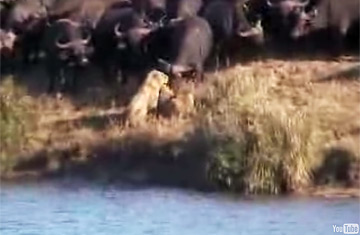
Click Here to Upgrade your Flash Player.
Not that you ever planned to mess with a cape buffalo, but if you did, here's a thought: Don't—especially if the way you were going to do it was by picking on one of his kids.
Cape buffalo aren't usually the stuff of news, but in the last month they've become the heroes of blogs, newsgroups and fan sites, ever since YouTube posted a video that may be the hottest upload in web history that doesn't include a naked famous person or a politician saying something career-ending. The 8-min., 23-sec. clip is a three-act play of attack, counterattack and rescue shot three summers ago in Kruger National Park in South Africa and posted only this May. Since then, it has been viewed more than 3.8 million times—200,000 times in a single day this week—drawn more than 6,000 comments and been bookmarked as a fan favorite more than 20,000 times. And a single viewing of the thriller in Kruger (though you're unlikely to watch it just once) shows why.
The smackdown took place at an ordinary watering hole where a small herd of cape buffalo were drinking and idling, wandering dangerously close to a pack of concealed lions that either did not smell very lion-like or, more probably, were crouching deliberately upwind. On the other side of the hole, six tourists and a guide watched in a parked range vehicle. The lions waited until the buffalo got close enough and then pounced, seizing the baby and scattering the adults. That's usually a game-ender for a baby buffalo, but things got even worse for this one as he struggled backwards, splashed part way into the water, and got his hind legs snagged by a pair of crocodiles. He somehow yanked free of them, but remained in the jaws of the lions until suddenly the adult cape buffalos stormed back in much greater numbers, dispersed the lions and made off with the remarkably unharmed baby.
"The guide told us that in his 15 years of doing this he'd never seen anything like it," American tourist Jason Schlosberg tells TIME. Schlosberg shot still pictures of the battle while a travelling companion, Dave Budzinski, shot the now-famous video.
The response from the YouTubers was less measured.
"Mess with one bean, you get the whole burrito," one posted.
"This is a disgrace for the lion family! Beaten by a cow!" said another.
Still others saw a larger message in the encounter. "A democratically elected government formed the LEMA (Lion Emergency Management Agency) which takes a little time to organize, but seems to come through in the end. We could learn something here."
"Majority rule, plain and simple," was how another put it.
Human geopolitics aside, what many wanted to know was just how common this kind of gang war is among species. Does such comparatively organized thrust and counterthrust occur routinely in nature, or were these unusually clever critters?
Certainly the battle for dinner between the lions and crocs was nothing unusual. Plenty of animals subscribe to the are-you-going-to-finish-that? school of eating, rarely waiting for the answer before trying to help themselves to someone else's meal. Even top predators like big jungle cats may spend as much time defending a kill as eating it, one of the reasons some of them will carry a carcass up into a tree before tucking in.
"It's common for two species to fight over a third. That's not unusual," says veterinarian and animal behaviorist Katherine Houpt of Cornell University.
What really surprised and delighted web viewers was the cavalry charge of the returning buffalos, who put themselves in the path of the predators to save the good-as-gone baby. Cape buffalo, after all, are not the MacArthur Fellows of the animal world. They're lumbering, quarrelsome and predictable in their movements and, says Houpt, "40% of them wind of them up in the belly of lions." But that means 60% don't, and the rescue that the Kruger group pulled off was actually nothing particularly special among herding species.
"These kinds of animals collaborate all the time," says the University of Pennsylvania's Sue McDonnell, also an animal behaviorist and vet. "The larger herd is broken down into smaller harems, with a domanant male and several females and their babies. If a youngster is threatened, both the harem males and bachelor males—which usually fight with one another—will get together to try to rescue it." You don't even have to travel to Africa to see such herbivorous first-responders at work. McDonnell specializes in studying wild horses and has occasionally seen the rough—sometimes lethal—treatment feral dogs receive when they're foolish enough to spook the group. Huzzahs for the heroism of the Kruger buffalos are fine for the web crowd, but for the herding males themselves, it's just part of the job description.
One question that's not answered—and probably not answerable—by either the video or the scientists is how well the beaten-up baby fared after the cameras stopped rolling. Certainly the right bite to the neck would have caused the baby to bleed out fast—which did not appear to happen—and the right hold on its hind legs would have broken them, making it impossible for him to trot back to the herd as he did. Buffalo hide is tough, and perhaps this baby was even tougher and scrappier than most—or perhaps the crocs and lions simply had their B-teams out that day. Whatever the answer, one of the best thing about the alternate-reality, user-driven world of the Web is the freedom it provides—in the absence of alternative evidence—to invent the endings we'd like to see. Judging by the 6,000-plus responses, in the YouTube world at least, the baby's doing just fine.
